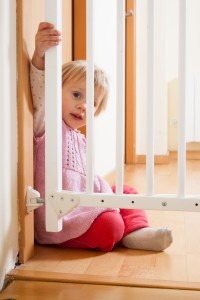Home Safety – What Every Parent Needs To Know

Whether you have a baby, toddler or young child in the home, taking preventive measures to avoid accidents can ensure home safety and the wellbeing of your children. Home injuries are a leading source of accidental death for children, so it’s important that you always supervise your kids and keep your home safe.
The following is a guide to home safety, keeping your children safe at home, both indoors and outdoors.
Kitchen
- Remove small items to prevent your child from swallowing and choking on them.
- Place sharp objects such as knives, scissors and graters in lockable drawers or out of reach.
- Keep containers with hot liquids also out of reach.
- Cook with the saucepan handle turned towards the back of the stove.
- Wrap cords tightly with a twist tie.
- Store any cleaning fluids, food processors and blenders in locked cabinets.
- Don’t allow your child to go into the kitchen pantry.
Bathroom, toilet and laundry
- Install safety gates and locks on the doors to prevent your child from entering alone.
- Store cleaning products, detergents, medicines, hair products, deodorants and razors out of reach or in locked cabinets.
- Don’t leave cosmetics and toiletries within easy reach.
- Install safety taps that your child can’t turn on and label hot and cold taps clearly and correctly.
- Lower the temperature of your hot water thermostat to 50°C.
- Test the water temperature to ensure that it’s not too hot or too cold before giving your child a bath.
- Don’t ever leave your child alone in the bathtub, sink or bucket, even for a few seconds – if the phone or doorbell rings, take them with you.
- Watch and monitor your child while they’re using the toilet.
- Don’t keep large buckets/containers of liquid around as your child can drown in them.
- Close the bathroom, toilet and laundry doors when not in use.
Stairway and hallway
- Install stair nosings that glow in the dark so the staircase remains visible at night.
- Install safety gates at the top and bottom of the staircase.
- Keep the stair and hallway clear and free of clutter to prevent accidental falls.
- Leave the light on in the hallway at night or use a low-power nightlight to prevent your child from tripping when they go to the toilet.
Living areas and bedrooms
- Remove small objects – like buttons, beads, marbles and coins.
- Lock cabinets that are within reach of your child.
- Install a child-resistant lock on the door of your baby’s room to prevent other children from entering unsupervised.
- Don’t lock your child in the room.
- Don’t let your child sit on a high bed or counter unattended.
- If you have a workshop or hobby room that contains potential hazards, close the door and install a doorknob cover or a childproof lock.
Clothes, shoes and bags
- Store clothes and shoes properly in closets, cabinets or cupboards.
- When the weather gets colder, dress your baby in warmer pyjamas or use sleep sacks.
- Keep purses, handbags, briefcases and gym bags out of your child’s reach, as they may contain small hazardous/choking items, e.g. medicine, breath mints, coins, gums, candies, cosmetics, keys, cigarettes and matches.
Furniture and equipment
- Bolt bookcases and other tall pieces of furniture to the wall.
- Use furniture with round corners or cover sharp corners with foam or cushioning.
- Buy furniture and fabrics with low-flammability materials.
- If you have a toddler, don’t use tablecloths and don’t run a fan on the floor because they have small fingers that can enter the fan’s grill area.
- Use swivel outlet covers for vacuums instead of plastic ones as these are not safe and could choke your child.
- Prevent gadgets, computers and coffee pots from tipping over by placing them properly on their designated table/bench and managing cords/cables appropriately.
Baby furniture and equipment
- If you have a baby, use a crib with two-inch gaps and don’t place it near the window.
- Remove any drapery and blind cords around the crib.
- Keep the crib as bare as possible to prevent your baby from suffocating.
- Use a light, snug-fitting blanket that your baby can’t pull away from the corners (e.g. tuck the bottom of the blanket beneath the end of the mattress to create a pocket – the blanket should only reach up to the centre of your baby’s chest).
- Keep everything you need in your baby’s changing area within easy reach so you don’t have to leave your baby alone.
- Use equipment with the Australian Standards label.
Front and backyards
- Fence the yard and also install a compliant fence with a self-locking gate around your pool, spa or fishpond.
- Empty out your kiddie pool (e.g. wading or splash pool) when it’s not in use.
- Cover hot tubs when they’re not in use.
- Place an alarm system on doors that lead out to the pool area.
- Keep hand/power tools, garden equipment, cleaners, insecticides and fertilisers safely locked away in cabinets and out of reach.
- Unplug tools when you’re not using them.
Windows and doors
- Lock windows and doors or install screens and keep them securely in place.
- Install Fallsafe screens on your windows.
- Don’t allow your child to play near windows and patio doors as they could fall through the glass.
- Don’t store or display any furniture or object near a window that your child could use to climb up on, e.g. chairs, pot plants and beds.
- Lock front, back and side doors to keep young children from going outside by themselves.
Balcony and deck
- Check that balcony/deck railings and slats are safe and meet safety codes, e.g. guardrails must be at least 1 metre high with vertical bars that are no more than 10 cm apart.
- Install safety guards across the entry to the balcony/deck.
- Don’t place furniture, pot plants or light objects near the edge of your balcony/deck.
- Keep balcony/deck doors closed at all times.
- Always supervise young children when they’re on the balcony/deck, e.g. watch around chairs, tables and grills where they might play and experiment.
Floors and glass
- Clean and vacuum floors.
- Wipe up spills immediately.
- Don’t use loose floor coverings such as rugs as they can be slippery, or lay anti-skid mats underneath them.
- Offer your child drinks in plastic cups or shatterproof glasses.
- Put stickers on glass surfaces at your child’s eye level so that they don’t bump into them.
- Install safety glass in windows, doors and side panels or cover glass surfaces with sticky plastic film to prevent them from shattering when they break.
- Don’t use furniture with glass or keep them in child-free areas.
- Sweep up broken glass straightaway.
Small items, toys and food
- Store small household items away from a child’s reach, such as coins, buttons, jewellery, small balls and pins.
- Seal the battery compartments of toys, remote controls, desk clocks and battery-operated toothbrushes with tape.
- Don’t buy small toys or those with many small parts for children under 3 as they can choke on them.
- Cut large food into bite-sized pieces so that your child doesn’t choke on them either.
- Keep small foods out of reach, e.g. grapes, olives, lollies, nuts, and popcorn.
Family pet
- If you have pets, teach your child to stay away from pet food and pet faeces, as well as the litter and trashcan.
- Also teach your child to treat pets with care and not to play rough games or wrestle with them.
- Tell your child not to take away a toy, bone or treat from your pet or approach them while they’re eating.
- Warn your child to stay away from your pet if they’re caring for their young, growling or baring their teeth.
- Spay or neuter your pet to reduce aggressive behaviour.
Electricity, fire and gas
- Install a safety switch or a mains-operated circuit breaker.
- Keep electrical cords out of reach and cover the outlets with plastic socket covers when not in use.
- Repair, replace or remove damaged appliances and electrical cords.
- Don’t let your child go near electrical appliances.
- Never use a hairdryer or radio near water.
- Fix heaters and fireplaces to the wall and install fireguard screens.
- Install a smoke alarm and carbon monoxide detector on every level of your house, test them regularly and maintain them properly.
- Have a fire escape plan.
Prepare for emergencies
- Learn CPR (cardiopulmonary resuscitation) and the abdominal thrust procedure (also known as the Heimlich manoeuvre).
- Pin up a chart of basic resuscitation techniques on your pool fence or in other areas of your home.
- Have a first-aid kit with emergency instructions.
- Keep emergency numbers and safety contacts near your phone, including the police, ambulance, fire department, hospital, doctor, nurse, paediatrician, poison control, trusted neighbours and relatives.
It’s vitally important that you prevent your children from getting into accidents in the home. Your home should be a place where your kids as well as other people’s children can have fun and be safe. Any potential threats in the home must be removed, altered or kept out of reach from children. By childproofing your home and teaching your kids safety rules, you should be able to avoid serious injuries and accidents.



Share